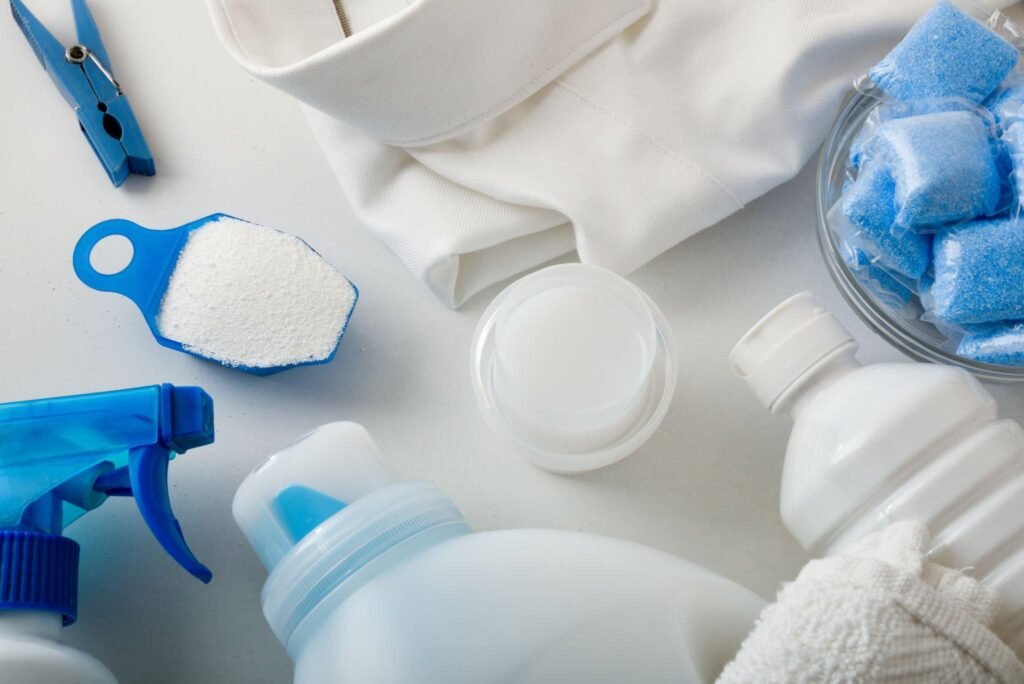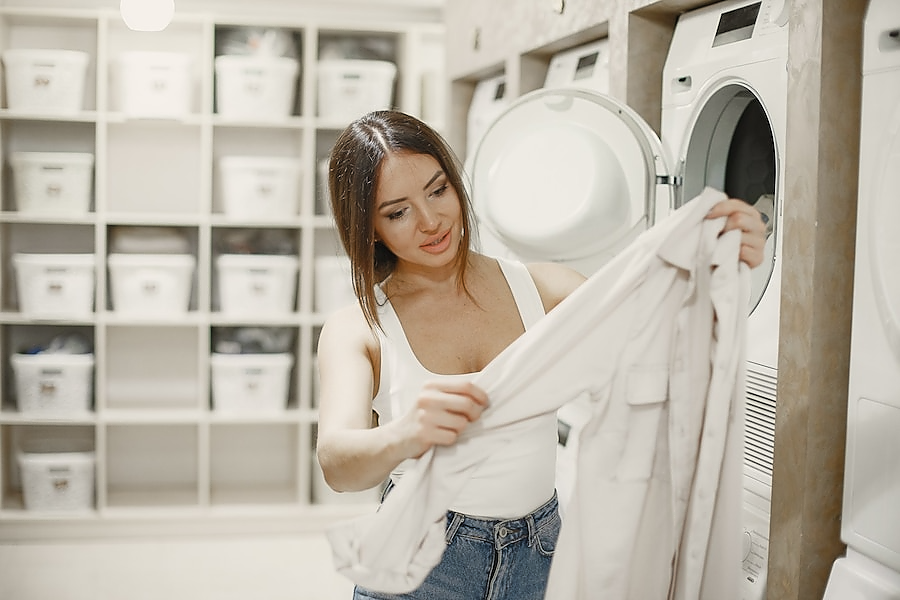What Is Taffeta Fabric? A Complete Guide to Properties of Taffeta, How Taffeta Is Made, and Where It Comes From
When you ask, “What is taffeta fabric?” You’re asking about a textile...
You know the feeling—you open your laundry to find your once bright white t-shirts now looking dull and gray. Bleach to the rescue! When it comes to whitening whites, bleach is the superhero of laundry day. A little bleach goes a long way toward brightening up your clothes whites and making them sparkle like new. But before you dump a whole bottle of bleach in with the next load, it pays to understand the different types of bleach and how much to use for the best results without damaging your clothes.
Follow these tips on how to bleach clothes for the brightest whites, and you’ll be sporting crisp white t-shirts, socks, and sheets in no time.
Bleaching white clothes is the only way to get them bright white again after yellowing and stains have set in. Here’s why bleaching clothes is worth the effort:
Bleach contains active ingredients like sodium hypochlorite that help lift stains and whiten fabrics. By bleaching your clothes white, you can get them back to a bright, brilliant white and remove any yellowing. Over time, white fabrics get dull from dirt, grime, and body oils; bleaching helps restore their vibrancy.
Bleach also helps eliminate odors trapped in fabrics by killing the bacteria that can lead to musty smells. Your whites will smell freshly laundered after bleaching.
By eliminating any bacteria, viruses, and other germs that may be present, bleach helps sanitize your white clothing. For items like bed linens, towels, and white socks, this is especially crucial. Bleach provides an extra level of cleanliness and sanitation for your laundry.
By bleaching white clothes regularly, you can extend their lifespan. The whitening and brightening effect helps clothes look newer for longer and prevents premature aging. Whites that turn yellow or gray quickly due to a lack of bleaching often need to be replaced sooner.
Bleaching your white laundry has so many benefits and helps keep your clothes looking and smelling their best. For the whitest whites every time, be sure to add bleach to your wash cycle according to the directions on the product. Your bright whites will thank you!
To get your whites their whitest, you’ll need a few essential supplies.
With the proper supplies and by following the directions carefully, you’ll be well on your way to bright, fresh-smelling whites. Take your time and be cautious, but don’t be afraid to bleach—your whites will thank you for it!
How do I bleach a white shirt? To get the brightest whites from bleaching your fabric, mixing the proper bleach solution is key.
You’ll need:
The following are the procedures to follow to better understand how to bleach a white shirt:

Pre-treating any stains on your white clothes before bleaching is key to getting them as bright as possible. Here are some tips for tackling common stains:
For protein stains like blood, sweat, or food, soak the item in cold water before washing. Use a stain remover with enzymes or ammonia, scrubbing it into the fabric. Ideally, give it 30 minutes to sit. Longer is better when it comes to blotting out stains.
For grease stains, apply a stain remover with detergent and scrub the stain. Baking soda or cornstarch can also help absorb the oil. Let it sit before washing. You may need to repeat the process a few times to fully remove a tough grease stain from white clothes.
For ground-in dirt or mud, scrape off any excess before it dries, and then pretreat the stain. Use a product containing bleach or hydrogen peroxide and launder the item on the hottest setting possible using a heavy-duty detergent. For stubborn stains, scrub the pretreatment into the fabric and let it soak in for up to several hours before washing.
Time is of the essence for red wine stains. To absorb as much wine as you can, blot with a crisp, white cloth. Dish soap, hydrogen peroxide, and water are combined in a tablespoon-sized mixture. Apply the solution and launder it as usual using a bleach alternative. The heat will cause the peroxide to further break down the stain. You may need to repeat to fully remove a wine stain from white clothes.
Following these pre-treatment steps before bleaching your white clothes will help lift tough stains and leave your whites whiter and brighter. With some elbow grease, even the most stubborn stains don’t stand a chance against these methods. Your whites will be sparkling in no time!
When bleaching white clothes, the method you choose depends on the fabric. Some types of fabrics handle bleaching better than others.
Can you bleach cotton? Cotton is very bleach-friendly and can handle full-strength bleach. For the whitest whites, use a ratio of 1 part bleach to 3 parts water. Soak the cotton items in the solution for no more than 30 minutes. Then launder as usual using a heavy-duty detergent and the warmest water setting possible. The heat will further boost the bleaching action.
Polyester fabrics can turn yellow if exposed to too much bleach. Dilute 3/4 cup of bleach in a gallon of water. Soak polyester clothes in the solution for only 15 minutes. Then rinse thoroughly with water to remove all bleach residue before washing separately from other laundry. The diluted bleach and short soaking time will brighten the polyester without damaging it.
For delicates like lace, linen, or rayon, create a very weak bleach solution of 1 tablespoon per gallon of water. Soak the items briefly—around 5 to 10 minutes max. The small amount of bleach will brighten and disinfect without risking damage to the delicate fibers. Be sure to rinse items separately on a gentle cycle using a mild detergent.
As with any laundry task, always follow the directions on the product packaging and never mix bleach with ammonia or any other chemical. Bleach can be safely used to brighten and disinfect many washable fabrics if you take proper precautions for the type of material. Choosing the right bleaching method will leave your white clothes dazzlingly bright without causing premature wear or damage.

Bleaching white clothes is quite straightforward. The key is using the proper products and techniques to lift stains and brighten fabrics without causing damage.
You’ll want to have:
Mix 3 parts water to 1 part bleach. For tough stains, you can use full-strength bleach. Add the solution to your spray bottle or bucket, and put on your gloves. Apply the bleach evenly to soiled and stained areas of white clothes. Let the item soak in for at least 30 minutes. For stubborn stains, scrub the area and reapply as needed.
Rinse the clothing thoroughly with water to remove all bleach residue. Laundry as usual, using a quality detergent and the warmest water setting possible. Add a booster like baking soda or a whitening product to further lift stains and boost brightness. Be careful and ventilate properly.
Never mix bleach with other cleaning products, especially ammonia, as this can create dangerous fumes. Always open the windows and use an exhaust fan when bleaching. Never bleach silk, wool, spandex, or non-colorfast prints. Bleach alternative products are non-chlorine, and color theory for clothing recommends safe bleaches if you prefer a gentler option.
By following these simple steps, you can safely and effectively bleach your white clothes for a brilliant, bright white finish. Your whites will be sparkling in no time!

Bleach works by oxidizing stains and dyes in fabric, breaking them down over time. The time it takes for bleach to whiten clothes depends on several factors:
The higher the concentration of bleach, the faster it will lighten fabrics. Regular household bleach is typically 5-8% sodium hypochlorite, while commercial bleaches can be up to 12%. Double the bleach concentration, and you can cut the treatment time in half.
Warmer water speeds up the chemical reaction that lightens fabrics. Bleach treatments in hot or warm water can lighten clothes in 30–60 minutes, while the same treatment in cold water may take 2-3 hours. For the fastest results, wash white clothes on the hot or warm cycle and add the bleach during the first rinse.
The lightest fabric types, like cotton, lighten faster than non-porous synthetic fabrics. Bleach can penetrate deeper into natural fibers, allowing for faster oxidation of dyes and stains. Delicate fabrics may require lower bleach concentrations to avoid damage, extending the time needed to reach your desired lightness.
How do I bleach colored clothes white? The more stained or dyed the fabric, the longer it will take for bleach to significantly lighten the clothes. For tough stains or heavily dyed fabrics, you may need to treat the clothes a few times to get the desired results. Check the clothes every 30 minutes to determine if another treatment is needed.
In the end, for most average loads of white cotton clothes in warm or hot water, you can expect regular household bleach to significantly lighten your clothes within 1 to 2 hours. Be sure to check your clothes regularly to avoid over-bleaching, and enjoy your bright whites!
How do I bleach white clothes? By following these simple steps for bleaching white clothes, your whites will be whiter than white. No more dingy t-shirts or graying socks—just crisp, clean clothes that make you feel fresh and put-together. Even a custom clothing manufacturer will tell you that proper care is key to keeping garments looking their best.
The small investment in bleaching pays off big time in how clean and bright your whites become. So pour yourself a glass of lemonade, put on those bright whites, and enjoy the sunshine.